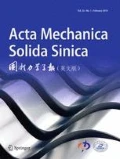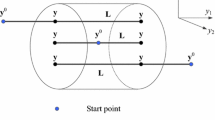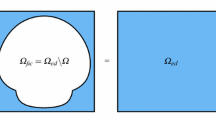Abstract
An adaptive cell-based domain integration method (CDIM) is proposed for the treatment of domain integrals in 3D boundary element method (BEM). The domain integrals are computed in background cells rather than volume elements. The cells are created from the boundary elements based on an adaptive oct-tree structure and no other discretization is needed. Cells containing the boundary elements are subdivided into smaller sub-cells adaptively according to the sizes and levels of the boundary elements; and the sub-cells outside the domain are deleted to obtain the desired accuracy. The method is applied in the 3D potential and elasticity problems in this paper.
Similar content being viewed by others
References
M. Jaswon, Integral equation methods in potential theory. I, in: Proceedings of the Royal Society of London. Series A. Mathematical and Physical Sciences, 275, 1963, pp. 23–32.
M.A. Jaswon, G.T. Symm, Integral Equation Methods in Potential Theory and Elastostatics, Oxford University Press, United Kingdom, 1977.
M.K. Chati, S. Mukherjee, Y.X. Mukherjee, The boundary node method for three-dimensional linear elasticity, Int. J. Numer. Methods Eng. 46 (8) (1999) 1163–1184.
J. Lv, Y. Miao, H. Zhu, Boundary node method based on parametric space for 2D elasticity, Eng. Anal. Boundary Elem. 37 (4) (2013) 659–665.
X. Li, J. Zhu, A Galerkin boundary node method and its convergence analysis, J. Comput. Appl. Math. 230 (1) (2009) 314–328.
Y. Miao, Y.-H. Wang, An improved hybrid boundary node method in two-dimensional solids, Acta Mech. Solida Sin. 18 (4) (2005) 307–315.
Y. Miao, Y.-h. Wang, Meshless analysis for three-dimensional elasticity with singular hybrid boundary node method, Appl. Math. Mech. 27 (5) (2006) 673–681.
Y. Miao, T. He, Q. Yang, J. Zheng, Multi-domain hybrid boundary node method for evaluating top-down crack in Asphalt pavements, Eng. Anal. Boundary Elem. 34 (9) (2010) 755–760.
Y. Miao, T. He, H. Luo, H. Zhu, Dual hybrid boundary node method for solving transient dynamic fracture problems, Comput. Model. Eng. Sci. (CMES) 85 (6) (2012) 481–498.
J. Zhang, X. Qin, X. Han, G. Li, A boundary face method for potential problems in three dimensions, Int. J. Numer. Methods Eng. 80 (3) (2009) 320–337.
F. Zhou, J. Zhang, X. Sheng, G. Li, Shape variable radial basis function and its application in dual reciprocity boundary face method, Eng. Anal. Boundary Elem. 35 (2) (2011) 244–252.
J. Lv, Y. Miao, H. Zhu, Y. Li, A Kriging interpolation-based boundary face method for 3D potential problems, Eng. Anal. Boundary Elem. 37 (5) (2013) 812–817.
S.-C. Hsiao, A. Mammoli, M. Ingber, The evaluation of domain integrals in complex multiply-connected three-dimensional geometries for boundary element methods, Comput. Mech. 32 (4-6) (2003) 226–233.
D. Nardini, C. Brebbia, A new approach to free vibration analysis using boundary elements, Appl. Math. Model. 7 (3) (1983) 157–162.
R. Schaback, Error estimates and condition numbers for radial basis function interpolation, Adv. Comput. Math. 3 (3) (1995) 251–264.
A. Neves, C. Brebbia, The multiple reciprocity boundary element method in elasticity: a new approach for transforming domain integrals to the boundary, Int. J. Numer. Methods Eng. 31 (4) (1991) 709–727.
S. Ahmad, P.K. Banerjee, Free vibration analysis by BEM using particular integrals, J. Eng. Mech. 112 (7) (1986) 682–695.
E. Pan, A. Chengz, Treatment of body forces in single-domain boundary integral equation method for anisotropic elasticity, Transformation of Domain Effects to the Boundary, 14, 2003, p. 95.
E. Pan, B. Amadei, A 3-D boundary element formulation of anisotropic elasticity with gravity, Appl. Math. Model. 20 (2) (1996) 114–120.
X.-W. Gao, The radial integration method for evaluation of domain integrals with boundary-only discretization, Eng. Anal. Boundary Elem. 26 (10) (2002) 905–916.
X.-W. Gao, Evaluation of regular and singular domain integrals with boundary-only discretization—theory and Fortran code, J. Comput. Appl. Math. 175 (2) (2005) 265–290.
S. Nintcheu Fata, Treatment of domain integrals in boundary element methods, Appl. Numer. Math. 62 (6) (2012) 720–735.
M. Hematiyan, A general method for evaluation of 2D and 3D domain integrals without domain discretization and its application in BEM, Comput. Mech. 39 (4) (2007) 509–520.
M. Hematiyan, A. Khosravifard, T. Bui, Efficient evaluation of weakly/strongly singular domain integrals in the BEM using a singular nodal integration method, Eng. Anal. Boundary Elem. 37 (4) (2013) 691–698.
Z. Sedaghatjoo, H. Adibi, Calculation of domain integrals of two dimensional boundary element method, Eng. Anal. Boundary Elem. 36 (12) (2012) 1917–1922.
R. Dallner, G. Kuhn, Efficient evaluation of volume integrals in the boundary element method, Comput. Methods Appl. Mech. Eng. 109 (1) (1993) 95–109.
M.S. Ingber, A.A. Mammoli, M.J. Brown, A comparison of domain integral evaluation techniques for boundary element methods, Int. J. Numer. Methods Eng. 52 (4) (2001) 417–432.
Y. Dong, C. Lu, Y. Li, J. Zhang, G. Xie, Y. Zhong, Accurate numerical evaluation of domain integrals in 3D boundary element method for transient heat conduction problem, Eng. Anal. Boundary Elem. 60 (2015) 89–94.
Y. Dong, J. Zhang, G. Xie, C. Lu, L. Han, P. Wang, A general algorithm for the numerical evaluation of domain integrals in 3D boundary element method for transient heat conduction, Eng. Anal. Boundary Elem. 51 (2015) 30–36.
H. Cheng, L. Greengard, V. Rokhlin, A fast adaptive multipole algorithm in three dimensions, J. Comput. Phys. 155 (2) (1999) 468–498.
Y. Fu, K.J. Klimkowski, G.J. Rodin, E. Berger, J.C. Browne, J.K. Singer, R.A. Van De Geijn, K.S. Vemaganti, A fast solution method for three-dimensional many-particle problems of linear elasticity, Int. J. Numer. Methods Eng. 42 (7) (1998) 1215–1229.
Q. Wang, Y. Miao, H. Zhu, A fast multipole hybrid boundary node method for composite materials, Comput. Mech. 51 (6) (2013) 885–897.
Q. Wang, Y. Miao, J. Zheng, The hybrid boundary node method accelerated by fast multipole expansion technique for 3D elasticity, Comput. Model. Eng. Sci. 70 (2) (2010) 123–151.
Q. Wang, Y. Miao, H. Zhu, C. Zhang, An O (N) fast multipole hybrid boundary node method for 3D elasticity, Comput. Mater. Continua 28 (1) (2012) 1–25.
G. Of, O. Steinbach, P. Urthaler, Fast evaluation of volume potentials in boundary element methods, SIAM J. Sci. Comput. 32 (2) (2010) 585–602.
J. Ding, W. Ye, L. Gray, An accelerated surface discretization-based BEM approach for non-homogeneous linear problems in 3-D complex domains, Int. J. Numer. Methods Eng. 63 (12) (2005) 1775–1795.
O. Steinbach, L. Tchoualag, Fast Fourier transform for efficient evaluation of Newton potential in BEM, Appl. Numer. Math. 81 (2014) 1–14.
Y. Shiah, Y.-C. Chaing, T. Matsumoto, Analytical transformation of volume integral for the time-stepping BEM analysis of 2D transient heat conduction in anisotropic media, Eng. Anal. Boundary Elem. 64 (2016) 101–110.
W. Qu, W. Chen, Z. Fu, Solutions of 2D and 3D non-homogeneous potential problems by using a boundary element-collocation method, Eng. Anal. Boundary Elem. 60 (2015) 2–9.
J. Telles, A self-adaptive co-ordinate transformation for efficient numerical evaluation of general boundary element integrals, Int. J. Numer. Methods Eng. 24 (5) (1987) 959–973.
Author information
Authors and Affiliations
Corresponding authors
Rights and permissions
About this article
Cite this article
Wang, Q., Zhou, W., Cheng, Y. et al. An adaptive cell-based domain integration method for treatment of domain integrals in 3D boundary element method for potential and elasticity problems. Acta Mech. Solida Sin. 30, 99–111 (2017). https://doi.org/10.1016/j.camss.2016.08.002
Received:
Revised:
Accepted:
Published:
Issue Date:
DOI: https://doi.org/10.1016/j.camss.2016.08.002




